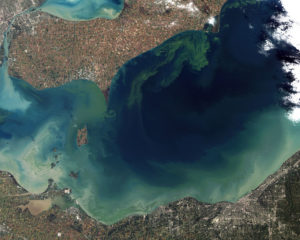Toxic algae blooms, runoff, and robots
August 6, 2017The good news is that there’s a new ally in the fight against toxic algae: underwater robots.
The bad news is that the algal blooms on Lake Erie “are expected to be worse than normal this year, well above the size at which they can potentially become harmful to aquatic life and even humans,” according to a story in the Detroit Free Press.

Reports state that the lake is in the midst of “the third or fourth largest” algal bloom on record this year. And that could be especially bad news for boaters, swimmers, fishers and those who rely on the lake for drinking water.
As we’ve written before, runoff carries nutrients — including excess fertilizer from farms — into the lake, which feeds the algae and causes the blooms (Buffer zones are one way to help prevent that problem). The blooms kill fish and other aquatic insects by reducing the amount of oxygen in the water. That may sound counter-intuitive – after all, plants create oxygen, right? Yes, but during the day, when sunlight powers photosynthesis. At night, the algae use oxygen, and in the summer, when the water is warm, there’s less dissolved oxygen available in the water than when the water is cold.
Another complication caused by the blooms is that they contain a toxin called microsystin, produced by bacteria in blue-green algae blooms. It can cause rashes, gastrointestinal problems, cold-like symptoms such as a cough or sore throat, and liver damage. And it’s not a problem limited to just large lakes — it can happen in any standing or slow-moving body of water. Just last year, an algae bloom in an Upper Mount Bethel Township pond was blamed for a fish kill.
Science is helping to predict the severity of the blooms, and each year new information helps to make the predictions more accurate. This year, according to the story, the biomass, or size, is expected to be a 7.5 out of 10. That’s better than a toxic bloom in 2015, but still severe. And the size of the bloom does not necessarily indicate its toxicity, something scientists are still trying to predict. A large bloom does not necessarily mean it will be especially toxic; a small bloom could be highly toxic.
The tiny robots we mentioned at the beginning of this post are helping with predictions, which can then help guide treatment methods. Called an “environmental sample processor (ESP),” the robots are like “a laboratory in a can, according to an Associated Press report. They stay underwater and monitor the blooms. The robots can relay information on the blooms almost immediately. “This is so great because in so many of these remote offshore locations, we can leave the lab out there and get this information in a matter of hours rather than days,” one of the scientists said.
Still, the best solution remains prevention — and that means reducing the amount of nutrients that get into our waterways in the first place.